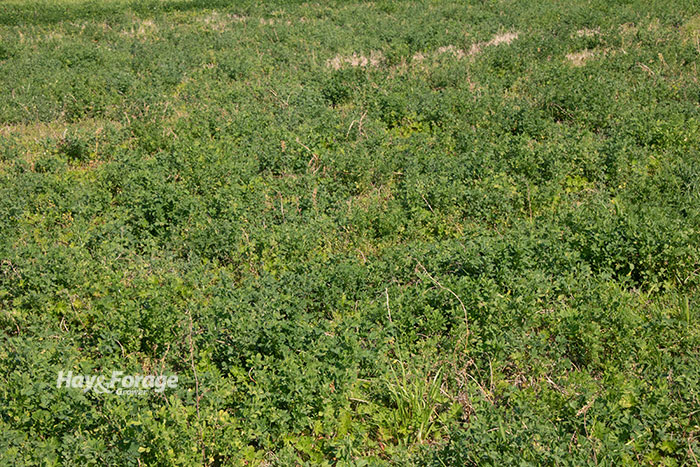It’s been a struggle for new alfalfa seedings |
| By Mike Rankin, Managing Editor |
|
|
 Really dry or really wet — it doesn’t matter because both conditions can be lethal to new spring alfalfa seedings. Depending on where you hang your hat, weather extremes on either end of the spectrum hampered the establishment of alfalfa in 2023. September is a good time to evaluate seeding-year alfalfa stands. If it was wet during the spring and early summer, it’s likely new seedings were hindered by flooding, wet-soil seedling diseases, silting, or possibly soil crusting. Conversely, dry springs are usually characterized by just enough rain for seed germination but not enough for seedling development. Essentially, the young roots get fried in the dry soil. Establishing alfalfa is a numbers game and even in the best of years, the batting average isn’t too good. Depending on the amount of seed coating, every 1 pound of seed dropped per acre equates to three to five seeds per square foot. Hence, a seeding rate of 15 pounds per acre is equivalent to 45 to 75 potential plants per square foot. Regardless of seeding rate, research verifies that it’s rare to find more than 25 to 35 plants per square foot by fall. Often, that number is less, and this year it may be far less. So, at what number of plants should you be concerned? Much depends on winter survival, but heading into winter with 15 plants per square foot shouldn’t be cause for losing sleep. Besides, at this juncture, you’re just making an assessment for possible action next spring. Often, by the end of the first production year, plant counts will be south of 10, but, at that point, stem counts are better at predicting potential yield. Three to four healthy plants per square foot can still make for productive alfalfa stands. Weather not always to blame When evaluating new alfalfa seedings this fall, consider that weather may not be the only or primary reason why stands are less than adequate. Factors such as low soil pH and fertility, herbicide carryover, excessive planting depth, and mechanical drill issues can also result in poor stands. All of these causes need to be eliminated before wet or dry conditions are targeted as the culprit. Don’t take a fall cutting from spring-seeded alfalfa stands that are currently marginal. The short-term tactic is to preserve as many alfalfa plants as possible through winter and into next summer. That said, new seedings generally are the last to succumb to winter’s fury. One exception to the fall cutting rule might be if a stand is infested with an annual grass such as foxtail. Although alfalfa will never smother itself out during winter, a thick stand of an annual grass will, and it’s better to remove the grass if possible, leaving a taller stubble than normal. Finally, make sure soil fertility, especially potassium levels, are in the optimum range before temperatures drop. Plan ahead Evaluating new alfalfa seedings now offers an indication of which fields to keep a close eye on next spring. If needed, there are several proven strategies that can be initiated next year to extend the life of marginal stands. Interseeding alfalfa into alfalfa is not typically recommended because of autotoxicity, but the success rate is better when done within 12 months of the initial seeding. It’s most likely to be successful where entire areas are absent or nearly absent of alfalfa plants. These might include either high or low portions of a field. Red clover is always an option for interseeding with a no-till drill, but many farmers don’t like to contend with its slower dry down rate, especially for dry hay. The best way to extend the useful life of a young, but thin, alfalfa stand is to interseed a perennial grass such as orchardgrass, tall fescue, or meadow fescue. This is sometimes routinely done to 3- or 4-year-old alfalfa stands, but there’s no reason why it can’t be done to younger stands as well. If only an additional one or possibly two years is desired from the alfalfa stand, then interseeding annual ryegrass or festulolium is a high-quality forage option. |
